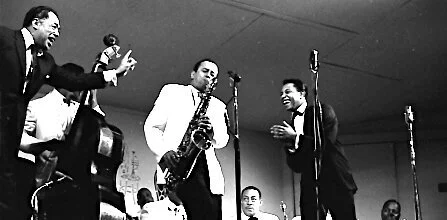Episode 1: The History
“It don’t mean a thing if it ain’t got that swing.”
Well, I don’t know if I’d go that far. After all, Beethoven’s Ninth Symphony means plenty, and it doesn’t exactly swing. Leonard Cohen’s “Alleluia” hews to a steady march that is more of a trudge than a lindy-hop. And “America, The Beautiful” doesn’t quite set your feet a-tappin’.
But Duke Ellington’s great song and jazz anthem? Well it says something essential about jazz music:
Swing. Jazz music swings. Back-and-forth. Dancers swaying. Fingers popping. Most jazz has an unmistakable effect on people. It makes them want to move.
All music—be it Beethoven or Bob Dylan—can certainly have a physical effect. It makes your neurons fire in particular ways, or drives your pulse to racing as it builds. Sitting in a concert hall, you might even wave your hand as you imagine conducting every emphatic beat of Handel’s “Hallelujah Chorus.” Who said Air Guitar was only for Aerosmith songs.
That impulse to move isn’t surprising. Music and dance are closely linked. Dylan certainly got a lot of people moving when he infamously picked up an electric guitar at Newport in 1965. And when people like Bach or Mozart weren’t composing for church, they had dancers in mind. It’s the kind of dancing you see in a Jane Austen movie: polite, intricate. Maybe it gets a little feisty when the wine is flowing. But classical music is typically steady, symmetrical, and even mathematical. It’s more road map than V-8 engine.
Jazz music, on the other hand, can be a hypnotic force, a driving energy that propels you and makes your body move.
Paul Gonsalves’ marathon solo at Newport.
Listen to an excerpt of Duke Ellington’s “Diminuendo in Blue,” recorded at the band’s landmark concert at the 1956 Newport Jazz Festival. (As with all music samples on STIJ, you can listen to a short excerpt right from the page, or log in to Spotify to hear the complete selection. Spotify playlists for each episode of STIJ are available at the Resources menu at the top of the page.) Tenor saxophone player Paul Gonsalves electrifies the crowed with a just-won’t-quit solo that goes on for a full six minutes. (The solo starts at the four- minute mark.)
Not all jazz has that supercharged sense of drive and rhythm. The Ellington band—and the Count Basie band, which we’ll talk more about in the second episode—have roots in the styles of the 1930s and ‘40s, the so-called Swing Era. When hundreds of big bands like Basie’s and Ellington’s toured the country, playing for audiences who wanted to listen…and Dance!
As jazz evolved and changed, it took on other rhythmic feels and ideas—from Latin to rock ‘n’ roll. But the rhythmic roots of swing continue to be one of the essential qualities of jazz music.
The Birthplace: New Orleans
What makes jazz swing? Where did that rhythmic feel come from? How is it different than European classical music? To get into that, you need to go back to the beginning.
You could spend a career trying to come up with a definitive origin story of jazz. But here’s a generally accepted shorthand version.
The place is the American “melting pot” of New Orleans in the 19th century. In the early 1800s and before, the city was under many different flags: France, Spain, the United States. The population was polyglot: Native Americans along with people from West Africa, Spain, the Caribbean, France and elsewhere. In the years leading up to the Civil War, immigrants from Germany, Ireland and Italy flooded in to the port city and added to the multiethnic mix.
Culture—particularly music and dancing—flourished. Different ethnic groups weren’t as segregated as in other cities, so the New Orleans geography allowed different traditions to mix and intermingle. Europeans brought the music of dance halls and marching bands. So-called Creoles of color (people of mixed European and African blood) were trained in European classical traditions, and saw music as a sign of coveted membership in high society. Other African-Americans brought rural blues, and still others brought African traditions and rhythms into the mix.
Photo Cards from the early 1920s of early music New Orleans ensembles.
When post-Civil-War Jim Crow laws extended the definition of being “Negro” to anyone with any percentage of African blood, Creoles of color lost some of the social standing that allowed them to remain culturally and geographically separate. The cultural interchange between mixed-race Creoles and Africans became even stronger.
That environment was the medium for the birth of jazz.
To explore the music that came out of New Orleans, go on to “Episode 2: The Rhythm.”



